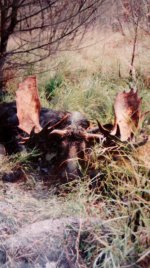Guy Miner
Master Loader
- Apr 6, 2006
- 18,100
- 7,710
I've been following a thread over on 24 Hour Campfire, in which various cartridges & bullets for brown bear are being discussed. John gave me permission to quote a post he made over there. I thought it might be of some interest here. I like the way John writes, and respect his opinion:
"I also have a large collection of recovered bullets, all from animals that died. Since these discussions always seem to come down to Barnes X against every other bullet, here are some statistics from my collection:
Many people state that Nosler Partitions retain around 60% or 65% or 2/3 of their weight. In my collection, 20% retained 60% or less, and those averaged 57.8%. All of those bullets were relatively light for caliber, ranging from 100 to 150 grains in calibers from .25 to 7mm.
There's a reason for this: Nosler designs the lighter, smaller-caliber Partitions to retain less weight, figuring they'll mostly be used on "deer-sized" game. John Nosler always believed (based on considerable experience) that deer die quicker with more bullet fragmentation.
But I should probably also note that the lightest retained percentage of a recovered Partition in my collection is a 150-grain .270, shot into a medium-sized Shiras bull moose. The bullet entered the left rear of the rib-cage and ended up in the right shoulder, retaining 53.7% of its weight. Yet the bull took a step-and-a-half before folding up dead.
The Partitions over .30 caliber have the Partition moved forward to retain more weight, because the folks at Nosler figure they'll be used on bigger animals. I've recovered some in calibers from .338 to .416 from animals like bull moose, musk ox, bison and Cape buffalo, and they average 86.3% weight retention.
Have also shot some Barnes X's into animals here and there, and recovered some, though not as many as Partitions, mostly because I've been shooting Partitions since the mid-1970's and Barnes X's--from the original to the blue-coated XLC to TSX's--since the mid-1990's. (Actually did shoot a few at targets before then, but never could get them to shoot well enough to want to take them afield.) The recovered X's average 90.6% in weigh retention.
Have recovered a higher percentage of X's than Partitions, but only because I've tended to use lighter X's for various sizes of game than Partitions.
Have done considerable experimentation with bullet penetration in consistent media of various sorts, and eventually came to the conclusion that depth of penetration is more tied to frontal area of the mushroom than percentage of weight retention. This is due to testing the same weight and diameter of various bullets at the same velocity: In every instance some bullets that retained less weight penetrated just as deeply as bullets that retained more--and the difference was in the measured diameter of the mushroom.
Whether or not all of this makes any difference in "killing power" is debatable. I've only noticed that expanding bullets placed in the vitals kill stuff pretty quickly--but do know that extrapolating the penetration of some bullets of a certain make to ALL bullets of a certain make is a mistake. Some Partitions simply penetrate better than others, even if not one of the over-.30's with the Partition moved forward. I'd put the 160/175 7mm and 200 .30 in this class, but have also seen consistently deeper penetration from the 250 .338 and 286 9.3 than some other over-.30 bullets.
I'd have to say the same about Barnes X's. The 100-grain .25 TTSX hasn't penetrated any deeper than the 100-grain .25 Partition on the game my wife and I have shot with both--though both penetrate plenty, especially for the size of game they're usually used on.
Can't say that my hunting notes reveal any pattern in how far game has gone after a good hit in the vitals that exited or didn't exit. Have seen plenty drop very quickly, like that moose my wife killed with a lousy .270, from lung shots that didn't hit any major bone. Have also seen the same thing with bullets that did exit, whatever the make of the bullet, but can't find any statistical pattern.
_________________________
John"
Thoughts? Guy
"I also have a large collection of recovered bullets, all from animals that died. Since these discussions always seem to come down to Barnes X against every other bullet, here are some statistics from my collection:
Many people state that Nosler Partitions retain around 60% or 65% or 2/3 of their weight. In my collection, 20% retained 60% or less, and those averaged 57.8%. All of those bullets were relatively light for caliber, ranging from 100 to 150 grains in calibers from .25 to 7mm.
There's a reason for this: Nosler designs the lighter, smaller-caliber Partitions to retain less weight, figuring they'll mostly be used on "deer-sized" game. John Nosler always believed (based on considerable experience) that deer die quicker with more bullet fragmentation.
But I should probably also note that the lightest retained percentage of a recovered Partition in my collection is a 150-grain .270, shot into a medium-sized Shiras bull moose. The bullet entered the left rear of the rib-cage and ended up in the right shoulder, retaining 53.7% of its weight. Yet the bull took a step-and-a-half before folding up dead.
The Partitions over .30 caliber have the Partition moved forward to retain more weight, because the folks at Nosler figure they'll be used on bigger animals. I've recovered some in calibers from .338 to .416 from animals like bull moose, musk ox, bison and Cape buffalo, and they average 86.3% weight retention.
Have also shot some Barnes X's into animals here and there, and recovered some, though not as many as Partitions, mostly because I've been shooting Partitions since the mid-1970's and Barnes X's--from the original to the blue-coated XLC to TSX's--since the mid-1990's. (Actually did shoot a few at targets before then, but never could get them to shoot well enough to want to take them afield.) The recovered X's average 90.6% in weigh retention.
Have recovered a higher percentage of X's than Partitions, but only because I've tended to use lighter X's for various sizes of game than Partitions.
Have done considerable experimentation with bullet penetration in consistent media of various sorts, and eventually came to the conclusion that depth of penetration is more tied to frontal area of the mushroom than percentage of weight retention. This is due to testing the same weight and diameter of various bullets at the same velocity: In every instance some bullets that retained less weight penetrated just as deeply as bullets that retained more--and the difference was in the measured diameter of the mushroom.
Whether or not all of this makes any difference in "killing power" is debatable. I've only noticed that expanding bullets placed in the vitals kill stuff pretty quickly--but do know that extrapolating the penetration of some bullets of a certain make to ALL bullets of a certain make is a mistake. Some Partitions simply penetrate better than others, even if not one of the over-.30's with the Partition moved forward. I'd put the 160/175 7mm and 200 .30 in this class, but have also seen consistently deeper penetration from the 250 .338 and 286 9.3 than some other over-.30 bullets.
I'd have to say the same about Barnes X's. The 100-grain .25 TTSX hasn't penetrated any deeper than the 100-grain .25 Partition on the game my wife and I have shot with both--though both penetrate plenty, especially for the size of game they're usually used on.
Can't say that my hunting notes reveal any pattern in how far game has gone after a good hit in the vitals that exited or didn't exit. Have seen plenty drop very quickly, like that moose my wife killed with a lousy .270, from lung shots that didn't hit any major bone. Have also seen the same thing with bullets that did exit, whatever the make of the bullet, but can't find any statistical pattern.
_________________________
John"
Thoughts? Guy






